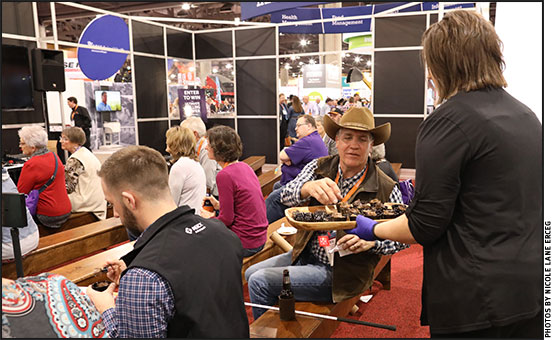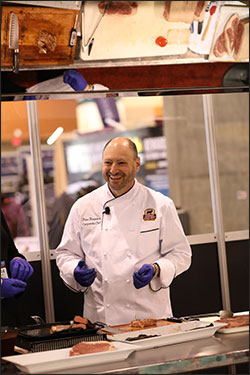
The Best Beef Every Time
CAB chef shares cooking tips with trade show attendees.
Most days it’s ranchers who are the beef experts.
Not so in the Learning Lounge at the Cattle Industry Convention & NCBA Trade Show. For a few short hours, Chef Peter Rosenberg schooled a ranching audience on how best to prepare beef.
From slow cooker recipes to grilling, roasts and knife recommendations, the Certified Angus Beef® (CAB®) brand chef captivated the audience sharing his familiarity with the end product that so many of the onlookers work to produce.
When it comes to questions of tenderness, Rosenberg says you can cook a variety of beef cuts and still get an eating experience the whole family will enjoy.
“There’s a lot you can do in preparation to slowly cook beef; slice it across the grain and slice it thin to preserve tenderness,” he says. “However, it’s always easier when you start with a high-quality, well-marbled product.”
A West Coast special
The convention setting in Phoenix had Rosenberg highlighting a regional cut that can’t always be found in butcher shops, grocery stores or ranch beef freezers — the tri-tip. It’s a triangular cut from the bottom sirloin subprimal that’s most popular on the West Coast.
“Consider it the brisket of the West,” Rosenberg says.

For a few short hours, in the Learning Lounge at the Cattle Industry Convention & NCBA Trade Show, Chef Peter Rosenberg schooled a ranching audience on how best to prepare beef.
For tri-tip, he recommends cooking the center to medium rare, putting a light smoke on the outside and seasoning with just salt and pepper or a special Santa Maria blend. The unique piece of meat provided the perfect demonstration for cutting across the grain to preserve tenderness. The tri-tip is tricky, since the grain runs in two different directions and changes with the curve of the cut.
That’s why he recommends slicing it at the curve as the grain changes direction and then slicing each section separately to ensure everyone gets a tender bite.
Even those tasting the tender bites at the Learning Lounge who had never heard of a tri-tip were soon asking how to get one included in their family meal rotation.
“Just ask whoever is doing your beef fabrication to include a tri-tip or ask the butcher at your local meat counter,” Rosenberg recommends.
Preparing great beef every time always comes back to the basics of timing and temperature.
“Most people cook to the temperature they want to eat at,” he says. “For example, if you want a rare steak, then you might cook it to 130°F, not realizing that it will cook 5° to 8°F degrees more after you remove it from the heat source,” he says. “Cook to a few degrees below the temperature you want to eat at.”
Rosenberg advises home cooks to use a meat thermometer to check the temperature every time. To achieve rare, cook to 125°F, 135°F for medium rare, 145°F for medium, 150°F for medium well and 160°F for well done.
“Remember, the USDA recommends steaks and roasts be cooked to 145°F and then rested for three minutes,” he shares. “That will provide a medium cooked steak. To absolutely ensure food safety, ground beef should always be cooked to a minimum of 160°F. Always trust the thermometer to be safe; never rely on the color alone.”
Rosenberg aims to inspire all beef consumers to try something new with the product, even those who know every step from breeding to plated beef on the table. The creativity with beef is endless.
“Just try something different,” he encourages. “You might just find a new go-to cut.”

Editor’s Note: Nicole Lane Erceg is a producer communications specialist for Certified Angus Beef LLC. This article was written as part of Angus Media’s coverage of the 2018 Cattle Industry Convention & NCBA Trade Show.






